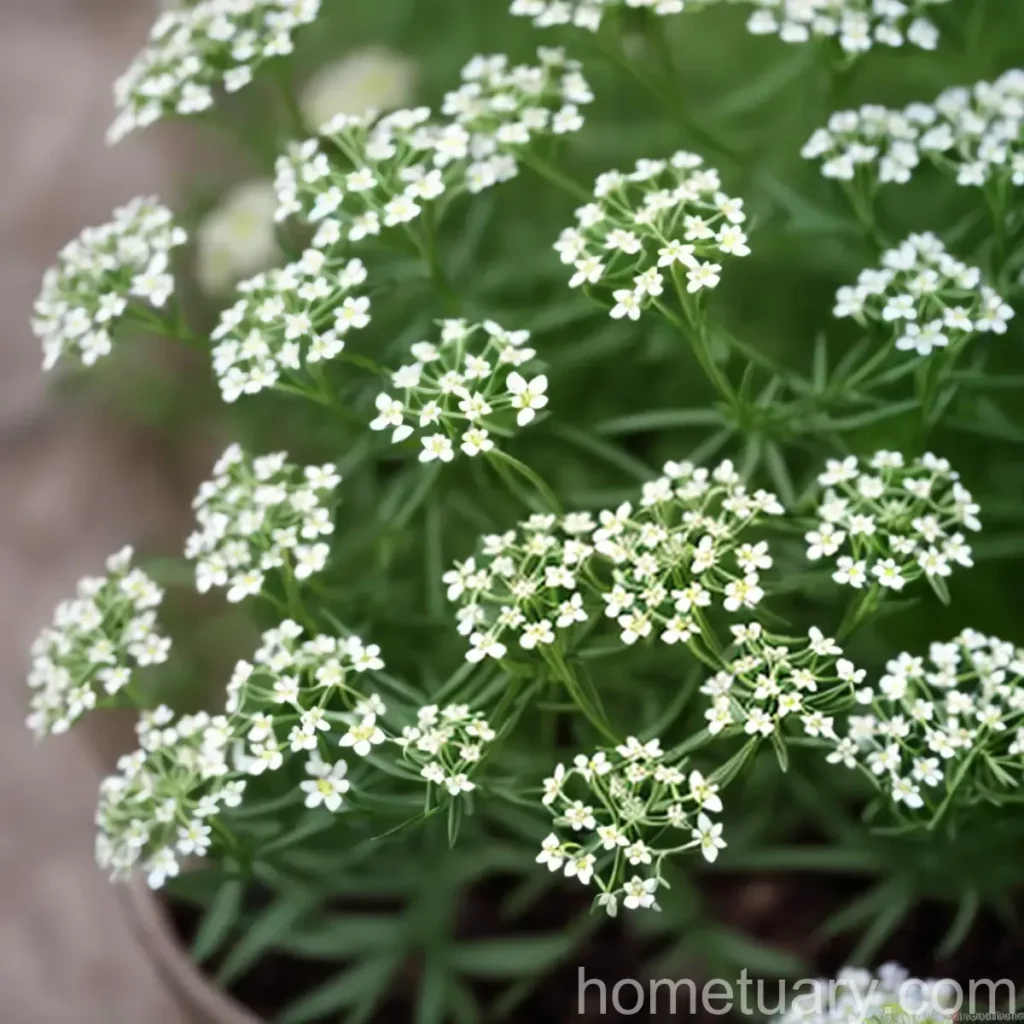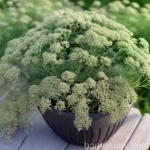The Wondrous World of Sweetscented Bedstraw (Galium odoratum)
Welcome to the fascinating world of plant science, where we delve into the intricate details of one of the most captivating plants – the Sweetscented Bedstraw. In this comprehensive guide, we will explore the various facets of this remarkable plant, from its cultural significance to its uses in herbal medicine and organic gardening. Whether you are a seasoned botanist, a gardening enthusiast, or simply someone intrigued by the wonders of nature, this article aims to provide you with a deep understanding of Galium odoratum, more commonly known as Sweetscented Bedstraw or Sweet Woodruff.
What is Plant: Sweetscented Bedstraw (Galium odoratum)
Sweetscented Bedstraw, scientifically known as Galium odoratum, is a perennial plant that belongs to the Rubiaceae family. Native to Europe, North Africa, and Western Asia, this herbaceous plant has captivated the attention of plant enthusiasts and herbalists for centuries due to its distinctive sweet fragrance and a myriad of traditional uses.
Botanical Details of Galium odoratum
- Scientific Name: Galium odoratum
- Common Names: Sweetscented Bedstraw, Sweet Woodruff, Fragrant Bedstraw
- Family: Rubiaceae
- Type: Perennial
- Native Regions: Europe, North Africa, Western Asia
- Growth Habit: Spreading, Ground-covering
Key Takeaways – Sweetscented Bedstraw (Galium odoratum)
Before delving into the intricate aspects of growing and caring for Sweetscented Bedstraw, let’s summarize the key takeaways about this fascinating plant.
Key Takeaways
-
Cultural Significance: Sweetscented Bedstraw has a rich historical and cultural significance, often associated with traditional folklore and spiritual practices.
-
Medicinal Properties: The plant is well-regarded for its traditional medicinal uses, offering a range of therapeutic benefits.
-
Gardening Uses: Sweetscented Bedstraw is a popular choice in gardens, valued for its aromatic foliage and ground-covering nature.
Now that we have established a general overview, let’s embark on a journey to explore the various aspects of Sweetscented Bedstraw, ranging from its cultural significance to practical cultivation and maintenance tips.
Cultural Significance of Sweetscented Bedstraw
Sweetscented Bedstraw, with its rich history and cultural significance, has become an integral part of traditions, folklore, and spiritual practices in various regions. The plant’s enchanting fragrance and aesthetic appeal have contributed to its profound symbolism in different cultures.
Folklore and Symbolism
-
In European folklore, Sweetscented Bedstraw was associated with love and romance. It was often used in bridal bouquets and wreaths as a symbol of devotion and affection.
-
The plant also held significance in pagan traditions, where it was believed to possess protective qualities and was used to ward off evil spirits.
Spiritual Practices
-
Sweetscented Bedstraw has been incorporated into spiritual practices such as aromatherapy and meditation due to its calming and soothing fragrance.
-
Some cultures perceive the plant as a symbol of purification and use it in ceremonial rituals for spiritual cleansing.
The enduring presence of Sweetscented Bedstraw in cultural traditions serves as a testament to its timeless allure and the profound impact it has had on human societies through the ages.
Uses of Sweetscented Bedstraw
Beyond its cultural significance, Sweetscented Bedstraw offers a multitude of practical uses, ranging from medicinal applications to ornamental and aromatic functions. Let’s explore the versatile uses of this remarkable plant.
Medicinal Properties
-
Sweetscented Bedstraw has been traditionally used in herbal medicine for its diuretic and anti-inflammatory properties. It has been employed to treat various ailments, including urinary issues and skin irritations.
-
The plant is valued for its mild sedative effects and is often used to promote relaxation and alleviate anxiety.
Aromatic Functions
-
The sweet, hay-like fragrance of the plant’s leaves makes it a popular choice for potpourris, sachets, and herbal crafts.
-
Sweetscented Bedstraw is utilized as a natural air freshener, imparting a subtle and refreshing scent to indoor spaces.
Culinary Uses
-
In traditional cuisines, the dried leaves of Sweetscented Bedstraw are employed to infuse beverages with a delicate aromatic flavor.
-
The plant is also used in the production of herbal teas and as a flavoring agent in desserts and alcoholic beverages.
Landscaping and Gardening
-
Sweetscented Bedstraw is favored for its role as a ground cover in landscaping, providing an attractive and fragrant carpet of greenery in shaded areas.
-
The plant’s sprawling growth habit makes it an excellent choice for filling in gaps in garden beds and under trees, adding a touch of natural elegance to outdoor spaces.
Cultural Significance
- Due to its historical and symbolic significance, Sweetscented Bedstraw continues to be used in cultural celebrations, folklore, and traditional ceremonies.
The diverse range of uses associated with Sweetscented Bedstraw underscores its multifaceted appeal and its enduring relevance in various domains, from traditional medicine to culinary arts and beyond.
Cultivation and Care of Sweetscented Bedstraw
Now that we have gained an appreciation for the cultural significance and practical uses of Sweetscented Bedstraw, it’s time to explore the best practices for cultivating and caring for this enchanting plant. From its preferences in terms of sunlight and soil to watering and pruning techniques, each aspect contributes to the overall health and vitality of Sweetscented Bedstraw.
Water
Sweetscented Bedstraw, with its preference for consistently moist soil, benefits from regular watering, especially during dry periods. However, it is essential to avoid waterlogging, as excessive moisture can lead to root rot. Striking a balance by ensuring adequate hydration without water accumulation is crucial for the plant’s well-being.
Sunlight
While Sweetscented Bedstraw thrives in shaded and partially shaded areas, it can tolerate moderate exposure to sunlight, particularly in cooler climates. However, intense and prolonged sun exposure may lead to wilting and reduced vigor. Finding a location with dappled sunlight or partial shade is ideal for promoting healthy growth and vibrant foliage.
Soil
The plant exhibits a preference for humus-rich, well-draining soil, providing a fertile foundation for its spreading growth pattern. A slightly acidic to neutral soil pH range is suitable for Sweetscented Bedstraw, ensuring optimal nutrient availability and root development.
Fertilizer
In nutrient-poor soils, applying a balanced, organic fertilizer during the growing season can support the plant’s growth and vigor. However, it is important to avoid excessive fertilization, as Sweetscented Bedstraw generally thrives in modest soil conditions and may become susceptible to issues related to over-fertilization.
Pruning
Regular pruning helps maintain the compact and tidy appearance of Sweetscented Bedstraw, preventing sprawling growth and maintaining an attractive form. Trimming back the plant after flowering or as needed can promote denser foliage and discourage leggy growth, contributing to a more visually appealing display.
Propagation
Sweetscented Bedstraw is readily propagated through division, allowing the versatile plant to spread and colonize new areas. Dividing the plant in early spring or fall enables the establishment of additional clusters, contributing to the plant’s naturalizing capabilities and providing an abundant supply for landscaping and gardening projects.
Container Popularity
Due to its low maintenance requirements and spreading growth habit, Sweetscented Bedstraw is a popular choice for container gardening, adding a touch of greenery and fragrance to outdoor living spaces, patios, and balconies. The plant’s adaptability to container culture makes it a versatile option for individuals seeking to incorporate natural elements into limited spaces.
Common Diseases and Pests Affecting Sweetscented Bedstraw
Despite its inherent resilience and adaptability, Sweetscented Bedstraw may encounter certain disease and pest issues that can affect its health and vitality. Identifying and addressing these challenges is crucial for safeguarding the plant and preserving its ornamental and aromatic qualities.
Common Diseases
-
Powdery Mildew: Under humid and overcrowded conditions, Sweetscented Bedstraw may be susceptible to powdery mildew, characterized by whitish fungal growth on the foliage. Improving air circulation and employing preventive measures can help mitigate this issue.
-
Root Rot: Prolonged waterlogging and excessively moist soil can lead to root rot in Sweetscented Bedstraw, causing wilted and discolored foliage. Implementing proper watering practices and improving soil drainage are essential for prevention.
Disease Diagnosis
-
Regular monitoring of the plant for signs of discoloration, wilting, or abnormal growth can aid in the early detection of potential diseases, allowing for prompt intervention and treatment.
-
Consulting with experienced gardeners or local plant health experts can provide valuable insights into disease diagnosis and management strategies tailored to the specific needs of Sweetscented Bedstraw.
Common Pests
-
Aphids: These small, sap-sucking insects can infest the tender growth of Sweetscented Bedstraw, leading to distorted foliage and reduced vigor. Natural predators and targeted interventions can help control aphid populations.
-
Spider Mites: Under dry and warm conditions, spider mites may pose a threat to Sweetscented Bedstraw, causing stippled and discolored leaves. Maintaining adequate humidity levels and employing natural control methods can limit their impact.
Botanist’s Tips for Growing Sweetscented Bedstraw
To ensure the successful cultivation and sustained prosperity of Sweetscented Bedstraw, it is beneficial to heed the wisdom and guidance of experienced botanists who have unraveled the plant’s mysteries and perfected its cultivation techniques over time. Here are some valuable tips from seasoned experts in the field of botany:
-
Choose Optimal Growing Conditions: Selecting a shaded or partially shaded location with well-draining, fertile soil sets the stage for robust growth and abundant foliage.
-
Monitor Soil Moisture: Regularly assess the moisture levels of the soil, ensuring adequate hydration without waterlogging, to promote healthy root development and lush foliage.
-
Implement Pruning Practices: Engage in periodic pruning to maintain the compact form of Sweetscented Bedstraw, enhancing its visual appeal and preventing rampant growth.
-
Embrace Natural Companion Plants: Integrate complementary plants with similar cultural requirements to create harmonious garden designs and horticultural ensembles that accentuate the charms of Sweetscented Bedstraw.
Fun Facts about Sweetscented Bedstraw
Unraveling the intriguing facets of Sweetscented Bedstraw unveils a treasure trove of captivating details and remarkable anecdotes that contribute to its timeless allure. Here are some delightful fun facts about this enchanting plant:
-
Historical Significance: Sweetscented Bedstraw has been associated with love and romance in European folklore and was a favored addition to bridal wreaths and garlands.
-
Aromatic Influences: The sweet, hay-like fragrance of Sweetscented Bedstraw has been cherished for centuries and has been utilized in various aromatic applications, from herbal crafts to natural air fresheners.
-
Medicinal Uses: Traditional herbal medicine systems revered Sweetscented Bedstraw for its therapeutic benefits, employing it to address an array of health concerns and promote well-being.
-
Cultural Symbolism: The plant’s presence in cultural traditions, spiritual practices, and historical gardens serves as a testament to its enduring symbolism and significance across diverse societies.
The amalgamation of cultural, medicinal, and aesthetic facets of Sweetscented Bedstraw enriches our understanding of this captivating plant, underlining its multifaceted nature and eternal appeal.
Links to External Resources
For further exploration of Sweetscented Bedstraw and related topics, the following resources offer invaluable insights and expert perspectives:
-
Royal Horticultural Society (RHS) – The official website of the RHS provides comprehensive information on plant care, gardening practices, and horticultural resources.
-
The Herb Society of America – A wealth of knowledge on herbal lore, culinary herbs, and medicinal plants can be found through the resources provided by the Herb Society of America.
-
Arbor Day Foundation – Discover a plethora of resources related to trees, shrubs, and ornamental plants, including insights into landscape design and sustainable gardening practices.
These external resources serve as valuable complements to the information presented in this article and offer opportunities for further exploration and learning.
Conclusion
Sweetscented Bedstraw, with its rich historical tapestry, versatile uses, and captivating allure, continues to enrapture plant enthusiasts and cultivators alike. From its role in traditional medicine and cultural customs to its ornamental and aromatic contributions to gardens and green spaces, the plant embodies a timeless elegance and a profound connection to human heritage.
As we conclude this exploration of Sweetscented Bedstraw, let us carry forth the appreciation for this remarkable plant and the knowledge gained about its cultivation, uses, and cultural significance. By embracing the wisdom of the past and the practical applications of the present, we can nurture and cherish Sweetscented Bedstraw, ensuring its enduring legacy in gardens, landscapes, and the hearts of plant aficionados worldwide.















